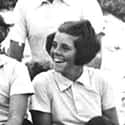-

(#9) Genevieve Pilarski
In 1944, Gennie Pilarski was admitted to a state psychiatric facility known as the Manteno State Hospital in Manteno, IL, after she and her parents had a disagreement about where she should live post-college. When she was admitted to the facility, a doctor described her as "neat, clean, tidy. Extremely quiet but friendly and agreeable. Cooperative in ward and routine." He even noted that there were "no signs of active pathology."
For some reason, instead of releasing Gennie on her own recognizance, the hospital staff subjected her to hydrotherapy, repeatedly plunging her into and out of ice water. Afterward, she asked: "Is life a farce?"
By May 1953, Gennie had undergone 187 electric shock therapies (two a week) and on February 18, 1955, she was subjected to an "extensive neurosurgery with bilateral extirpation of most of frontal and temporal lobes." This unnecessary surgery left Gennie "mute, [and] totally dependent on commands for functioning of everything from toilet urges on up."
None of this was reported to anyone, and for the next 45 years, she was shuffled between nursing homes and mental wards until she passed in 1998 at the age of 79.
-

(#10) Patricia Moen
According to Patricia, after being married to her husband for 13 years, she suddenly started crying constantly in 1962 at the age of 36. She told NPR, "I just mentally was no good," and one night while she was home alone, she took an entire bottle of pills in a last-ditch suicide attempt. That's when Dr. Walter Freeman suggested that she get a lobotomy, although he did warn her that there was a possibility that she would end up catatonic. According to Patricia, even though she couldn't remember the surgery or her time at the hospital, she did feel different after the doctor tinkered with her brain.
"I was a more free person after I'd had it. Just not to be so concerned about things... I just, I went home and started living, I guess is the best I can say - just started living again and was able to get back into taking care of things and cooking and shopping and that kind of thing..."
-
(#11) Howard Dully
- 70
As a 12-year-old boy, Howard Dully was described as defiant and "savage-looking." His doctor's notes on him at the time reveal a preteen with some mental issues who seems like he's trying to test his boundaries with his father and stepmother. From Dr. Walter Freeman's notes: "He doesn't react either to love or to punishment. He objects to going to bed but then sleeps well. He does a good deal of daydreaming and when asked about it he says 'I don't know.' He turns the room's lights on when there is broad sunlight outside."
In December 1960, Dr. Freeman performed a lobotomy on Dully and his entire nature seemed to change. Dully's stepmother noted that he "[sat] quietly, grinning most of the time and offering nothing."
It took Dully decades to understand what happened to him, and he still suffers from memory loss, but he feels like he's missing something. "Walter Freeman's operation was supposed to relieve suffering. In my case it did just the opposite. Ever since my lobotomy I've felt like a freak, ashamed," he said.
-
(#1) Rosemary Kennedy
- Dec. at 87 (1918-2005)
When Rosemary Kennedy was born, the medical community was still decades away from understanding dyslexia and other learning disabilities. The little sister of John F. Kennedy, Rosemary was misunderstood by her parents who struggled with her deficient cognitive skills.
Her father, Joe Kennedy, consulted the Psychology Department at Harvard University, where doctors evaluated Rosemary and concluded that she was developmentally disabled Her father consented to his daughter's frontal lobotomy when she was 23 years old. It was thought he was afraid his daughter might embarrass him and his son and hurt their chances in politics. She erupted into aggressive tantrums when she didn't get what she wanted.
In November 1941, Dr. Walter Freeman performed the surgery with Dr. James Watts, and they sliced away at the young woman's frontal lobe until the left side of her body was partially paralyzed.
After the surgery Rosemary was sent off to a mental institution where she had to relearn how to brush her teeth, walk, and dress herself. The bubbly and sometimes volcanically angry young woman was replaced with someone who was unable to talk.
In 2018, People published never-before-seen letters from Rosemary before she was lobotomized. The letters were addressed to her caretaker, Dorothy Smyth, an Irish woman who cared for Rosemary for a month-long period when she was 20. Rosemary recounted her adventures in Europe to Smyth, and she ended her letters with sign-offs like "Best Love from your darling Sweetheart."
-
(#8) Dave Rubinstein
- Dec. at 29 (1964-1993)
In the 1980s, Reagan Youth bashed out an intense, politically charged form of hardcore that managed to tow the line between brilliant dumbed-down circle pit anthems and trenchant critiques of the racist punk scene that was bubbling over throughout the decade. Unfortunately, the band's singer, Dave Rubinstein, had a nasty heroin habit and also got into a fight that left him with a head injury. Doctors informed him that he required lobotomy in order to recover.
After the surgery, Rubinstein technically recovered, but he was never again the punk rock intellectual that he was while fronting Reagan Youth. He quit singing with the band and threw himself completely into his addiction. In 1993, he took his own life after his girlfriend, Tiffany Bresciani, was murdered by the serial killer Joel Rifkin.
-
(#12) Randolph Stewart, 13th Earl of Galloway
- 90
Born in 1928, the Earl of Galloway was a slightly eccentric child who was eventually diagnosed with schizophrenia. When he turned 23, his parents took the unsuspecting Earl to a hospital in London where he was lobotomized. After the surgery, Stewart spent the next 15 years in the mental wing of the Crichton Royal Infirmary; then in 1970, his parents placed him in the Monastery of the Transfiguration in Roslin.
After finally leaving the monastery and marrying a commoner and shop girl, he said, "I was never the same again," referring to the lobotomy.
New Random Displays Display All By Ranking
About This Tool
For a while, Lobotomy brought unlimited hope to psychiatry. Many doctors used this method to remove the frontal lobes of critically ill patients so that they could become obedient and emotionally stable. But the terrible price came immediately. Many people undergoing surgery have degraded their intelligence to such an extent that they are unable to take care of themselves.
This irreparable lifelong damage has caused the inventors of the surgery to be criticized. The well-known lobotomy has also begun to be resisted all over the world. The random tool tells 12 true stories about lobotomy victims, some patients die from the surgery or commit suicide due to the sequelae of the surgery, and some have different types of disabilities.
Our data comes from Ranker, If you want to participate in the ranking of items displayed on this page, please click here.














